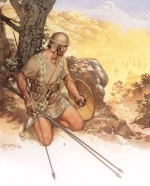Scutum
OPTIO

 
Cantidad de envíos : 1318
• Actividad : 1307
Fecha de inscripción : 29/05/2011
 |  Tema: moneda con la que se promociona el V concurso Tema: moneda con la que se promociona el V concurso  Lun 04 Nov 2013, 9:57 pm Lun 04 Nov 2013, 9:57 pm | |
| Buenas
¿Alguien me puede facilitar la imagen de la moneda que sale junto al guerrero con la que se promociona el V concurso de Imperio Numismático?
|
|
Admin
ADMINISTRADOR

 
Cantidad de envíos : 22533
• Actividad : 23305
Fecha de inscripción : 22/09/2008
 |  Tema: Re: moneda con la que se promociona el V concurso Tema: Re: moneda con la que se promociona el V concurso  Mar 05 Nov 2013, 11:02 pm Mar 05 Nov 2013, 11:02 pm | |
| Perdona, ahora no estoy en mi casa. No es un guerrero, es Minerva, reverso de un denario de Adriano con reverso COS III. |
|
Scutum
OPTIO

 
Cantidad de envíos : 1318
• Actividad : 1307
Fecha de inscripción : 29/05/2011
 |  Tema: Re: moneda con la que se promociona el V concurso Tema: Re: moneda con la que se promociona el V concurso  Mar 05 Nov 2013, 11:15 pm Mar 05 Nov 2013, 11:15 pm | |
| Me refiero a la del caballo, es una moneda con muchos detalles, se ve hasta la anilla de los correajes. Lo que lleva en la boca supongo que sera de las riendas, pero también había un objeto metálico así como eso que se usaba para cerrar la boca del caballo cuando hacia falta, emboscadas etc... |
|
Scutum
OPTIO

 
Cantidad de envíos : 1318
• Actividad : 1307
Fecha de inscripción : 29/05/2011
 |  Tema: Re: moneda con la que se promociona el V concurso Tema: Re: moneda con la que se promociona el V concurso  Miér 06 Nov 2013, 11:32 pm Miér 06 Nov 2013, 11:32 pm | |
| También me conformaría con saber que moneda es, ceca…. Para buscar si hay algún cuño igual o parecido. |
|
Admin
ADMINISTRADOR

 
Cantidad de envíos : 22533
• Actividad : 23305
Fecha de inscripción : 22/09/2008
 |  Tema: Re: moneda con la que se promociona el V concurso Tema: Re: moneda con la que se promociona el V concurso  Miér 06 Nov 2013, 11:33 pm Miér 06 Nov 2013, 11:33 pm | |
| No te preocupes. Te pasaré toda la información de ella mañana o pasao. Aún no estoy en mi casa. Estoy en la ciudad... |
|
Scutum
OPTIO

 
Cantidad de envíos : 1318
• Actividad : 1307
Fecha de inscripción : 29/05/2011
 |  Tema: Re: moneda con la que se promociona el V concurso Tema: Re: moneda con la que se promociona el V concurso  Lun 11 Nov 2013, 12:18 am Lun 11 Nov 2013, 12:18 am | |
| |
|
Admin
ADMINISTRADOR

 
Cantidad de envíos : 22533
• Actividad : 23305
Fecha de inscripción : 22/09/2008
 |  Tema: Re: moneda con la que se promociona el V concurso Tema: Re: moneda con la que se promociona el V concurso  Dom 24 Nov 2013, 6:38 pm Dom 24 Nov 2013, 6:38 pm | |
| aquí la tienes:  - Citación :
- Ionia, Ephesos (?) EL Stater. Circa 575-560 BC. Forepart of bridled horse left, sunburst before; lotus flower on its back / Rectangular incuse punch between two square incuse punches, all with roughly patterned surfaces. Weidauer 138 (these dies); Mitchiner 135; ACGC 56. 14.36g, 21mm.
Extremely Fine. Extremely Rare - the finest of only six specimens known. Sharply struck and lustrous.
The lotus flower that appears upon the horse's back is an element common to several electrum staters from uncertain mints attributed to Lydia or Ionia, all struck on the Milesian standard: the recumbent lion type (Rosen 245; NAC 72, 16 May 2013, 369), bull kneeling with its head reverted (Rosen 148), and two rampant lions upright on their hind legs with heads reverted and paws extended (Rosen 149). On all of these coins the lotus flower may initially appear incidental, though its commonality to all types indicates otherwise – it is evidently to be seen as the key element of the obverse type that links the different animal designs together.
The lotus flower appears only sporadically in Greek mythology, though it had a deep rooted use in Egyptian art and legend, where it was taken as a symbolic representation of the sun on account of its physical behaviour: it closes at night time and descends into the water, rising and flowering again at dawn. In Egyptian creation myth, the lotus was the first thing to spontaneously form from chaos, and it was from the lotus that the sun itself was born on the first day.
The eastern coastal areas of the Mediterranean in the sixth century BC had been for a long time familiar with Egyptian religious beliefs that spread as a consequence of trade and population dispersal; the lotus' insinuation in its Egyptian meaning into Greek culture is evident in the lotus-tipped sceptre carried by Zeus on the coinages of Karia, Mysia and Kilikia (among others), being a legacy of the assimilation of an attribute of the major Egyptian solar deity Ra with the principal god of the Greek pantheon Zeus. The lotus' appearance here as a polyvalent symbol can best be understood then in the context of assimilated Egyptian beliefs, representing at once both a solar and divine aspect, as well as a clear allusion to the minting city's location.
Interestingly however, the lotus is not the only solar element present on this coin – immediately before the horse's chest we can discern the presence of a sunburst similar in depiction to those found on the contemporary coinage of Alyattes. This element may have been included on account of its being more universally familiar, being well understood to signify what we now refer to as Anatolia, which comes from the Greek Aνατολή (Anatolē) meaning the 'East' or more literally 'sunrise', used to refer to the Ionian colonies on the west coast of Asia Minor. Moreover the horse was itself considered a solar symbol, not only throughout the East, but also among Celtic and Germanic tribes, suggesting a common ancient root to this association. Such preponderance of solar symbology is indeed only fitting for this metal, and is in fact an overt statement of the coin's composition: ἤλεκτρον, the Greek word for electrum, is derived from the word ἠλέκτωρ (ēlektōr) - 'shining sun'. No me acordaba donde la tenía. |
|
